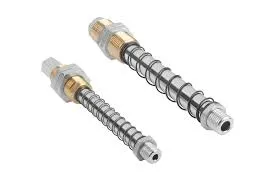In the world of mechanical components, the spring plunger plays a crucial role in ensuring precise positioning, indexing, and securing of parts. Found in countless industrial and consumer applications, spring plungers are small yet highly effective devices that improve the efficiency, safety, and reliability of mechanical systems. In this article, we will dive into what a spring plunger is, explore its different types, and discuss the various industries and applications where it shines.
What is a Spring Plunger?
A spring plunger is a mechanical device consisting of a ball or pin and an internal spring, housed within a threaded or non-threaded body. When installed, the spring-loaded ball or pin applies consistent force against a surface or component. This helps in positioning, locking, indexing, and even applying pressure where needed.
The design of a spring plunger ensures easy installation, adjustability, and removal. Due to their compact design, they are ideal for applications where space is limited but reliable performance is critical. Spring plungers are available in a variety of materials, including stainless steel, carbon steel, and plastic, depending on the environment they are meant for.
Types of Spring Plungers
There are several types of spring plungers, each designed for specific requirements:
1. Ball Plungers
Ball plungers are the most common type. They feature a small ball at the tip, which offers smooth engagement and disengagement. The ball reduces wear and tear and is ideal for applications that require frequent movement or repositioning.
2. Pin Plungers
Unlike ball plungers, pin plungers have a flat or rounded pin that moves in and out. Pin plungers are typically used where higher side-load resistance is needed. They are ideal for fixtures, tools, and heavy-duty equipment.
3. Hand Retractable Plungers
Hand retractable plungers have a knob or lever allowing manual retraction of the pin or ball. This type of spring plunger is used in setups where quick changes are required without the use of tools, such as adjustable platforms or conveyor systems.
4. Threaded and Press-Fit Plungers
Spring plungers can be either threaded for screw-in installation or smooth for press-fit applications. Threaded plungers allow easy adjustment and replacement, while press-fit designs are perfect for permanent installations where tampering must be minimized.
Applications of Spring Plungers
The versatility of the spring plunger makes it a staple in a wide variety of industries. Some common applications include:
– Manufacturing and Assembly Lines
In manufacturing, precision and reliability are key. Spring plungers are used to index machine parts, hold assemblies in place temporarily, and align fixtures accurately. They ensure parts move and stop exactly where they should.
– Automotive Industry
Automotive components demand strong, vibration-resistant connections. Spring plungers assist in securing panels, brackets, and custom fixtures, while allowing for quick adjustments during manufacturing or servicing.
– Electronics
Miniature spring plungers find their place in electronic devices where tiny components must be positioned with extreme accuracy. They help in the assembly of connectors, switches, and modular parts.
– Aerospace
In aerospace applications, where space is limited and reliability is non-negotiable, lightweight and corrosion-resistant spring plungers are used to hold panels, doors, and modular components.
– Furniture and Fixtures
Adjustable office chairs, shelving units, and display stands often incorporate spring plungers to allow height adjustments, secure locking, and ease of reconfiguration.
– Medical Equipment
Precision and cleanliness are vital in medical devices. Stainless steel spring plungers provide reliable positioning without corrosion, meeting the strict hygiene standards of the medical industry.
Choosing the Right Spring Plunger
When selecting a spring plunger, several factors must be considered:
- Load Requirements: The force exerted by the spring must match the application’s need for holding strength.
- Material Selection: In corrosive environments, stainless steel or plastic may be necessary.
- Operating Environment: Extreme temperatures or chemical exposure could dictate the choice of materials and coatings.
- Size and Installation Method: Make sure the plunger’s dimensions and installation style (threaded or press-fit) are appropriate for the design.
Properly chosen and installed spring plungers significantly enhance operational efficiency, reduce wear and tear, and contribute to overall system reliability.
Conclusion
Though small in size, the spring plunger is an essential component across many industries. Its ability to provide reliable positioning, indexing, and locking makes it indispensable in countless mechanical systems. By understanding the different types of spring plungers and their applications, engineers and designers can select the perfect solution to ensure optimal performance and longevity in their projects.



